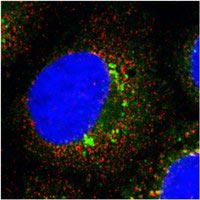UNC researchers discover how hepatitis C virus reprograms human liver cells

A cultured liver cancer cell infected with Hepatitis C. The virus, stained red, surrounds the blue-stained nucleus and is in the process of being reproduced by virus within the cytoplasm. Photo courtesy of Takahiro Masaki/UNC Lemon Lab <br>
Researchers at the University of North have discovered how hepatitis C binds with and repurposes a basic component of cellular metabolism known as a microRNA to help protect and replicate the virus.
A cultured liver cancer cell infected with Hepatitis C. The virus, stained red, surrounds the blue-stained nucleus and is in the process of being reproduced by virus within the cytoplasm. Photo courtesy of Takahiro Masaki/UNC Lemon Lab
In a paper published online in the Proceedings of the National Academy of Sciences Dec. 17, researchers in the laboratory of Stanley M. Lemon, MD, professor of medicine and microbiology and immunology and member of UNC Lineberger Comprehensive Cancer Center, the Center for Translational Immunology, and the UNC Center for Infectious Disease, outline the critical role the microRNA known as miR-122 plays in the life cycle of the hepatitis C virus.
A chronic blood-borne virus that attacks the liver, hepatitis C infects more than four million in the United States and more than 130 million worldwide. Deaths from the infection surpass those due to HIV/AIDS in the U.S. The virus is currently the leading factor in liver transplantation and a major cause of liver cancer, the third most fatal cancer worldwide and the ninth most deadly in the United States. Chronic hepatitis virus infections factor into more than two-thirds of liver cancer deaths.
“There is no cancer in the United States that is increasing in incidence as fast as liver cancer, and that is because of hepatitis C,” said Dr. Lemon.
One question has been why hepatitis C virus specifically targets the liver. The research of Dr. Lemon and his colleagues points to the interaction between the hepatitis virus and miR-122 as the explanation.
The human genome contains around 1,000 microRNAs, strands of cellular material that play a diverse role in regulating gene expression and cellular metabolism. In a healthy liver cell, the microRNA miR-122 regulates the activity and decay of numerous cellular RNAs responsible for the production of proteins. It normally functions to block protein expression or to promote degradation of RNAs in the cell. The hepatitis C virus genome is entirely RNA, but miR-122 acts on it in a completely different manner – stabilizing it and enhancing its ability to produce viral proteins. In effect, it promotes and protects the invader.
“MicroRNAs almost always promote the degradation of cellular RNAs. This is actually stabilizing the viral RNA,” said Dr. Lemon.
While Dr. Lemon’s team has explored the manner in which hepatitis C exploits miR-122 to protect the viral RNA in previous publications, the new research suggests a much deeper bond between the microRNA and virus. Hepatitis C RNA contains a site that binds directly to the microRNA, and the team has shown that the presence of miR122 is actually crucial for functioning of the virus. Dr. Lemon believes the virus has evolved a unique dependency and that it requires the host’s microRNA to reproduce.
“It is a relationship that is unique to hepatitis C and not seen, as far as we know, with any other virus,” said Dr. Lemon.
Because of the importance of miR-122 to the replication of hepatitis C, the microRNA presents a promising target for new drugs. The pharmaceutical industry has already begun developing therapies that target miR-122. Dr. Lemon said that his research will help explain the underlying biology behind why these drugs work and suggest new possibilities for treatment by targeting other enzymes and proteins that play a role in the interactions between the virus and miR-122.
“If you target miR-122 with a therapeutic that blocks its function or sequesters it so it is no longer accessible to the virus, the replication of the virus is severely impaired,” said Dr. Lemon.
This work was supported by National Institutes of Health Grants R01-AI095690 and P20-CA150343 and the North Carolina University Cancer Research Fund.
Media Contact
More Information:
http://www.unc.eduAll latest news from the category: Life Sciences and Chemistry
Articles and reports from the Life Sciences and chemistry area deal with applied and basic research into modern biology, chemistry and human medicine.
Valuable information can be found on a range of life sciences fields including bacteriology, biochemistry, bionics, bioinformatics, biophysics, biotechnology, genetics, geobotany, human biology, marine biology, microbiology, molecular biology, cellular biology, zoology, bioinorganic chemistry, microchemistry and environmental chemistry.
Newest articles

Bringing bio-inspired robots to life
Nebraska researcher Eric Markvicka gets NSF CAREER Award to pursue manufacture of novel materials for soft robotics and stretchable electronics. Engineers are increasingly eager to develop robots that mimic the…

Bella moths use poison to attract mates
Scientists are closer to finding out how. Pyrrolizidine alkaloids are as bitter and toxic as they are hard to pronounce. They’re produced by several different types of plants and are…

AI tool creates ‘synthetic’ images of cells
…for enhanced microscopy analysis. Observing individual cells through microscopes can reveal a range of important cell biological phenomena that frequently play a role in human diseases, but the process of…





















